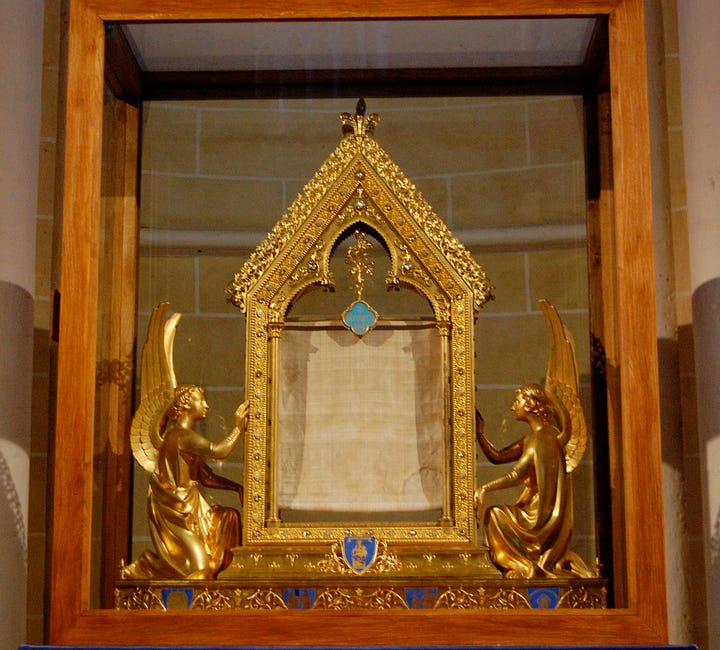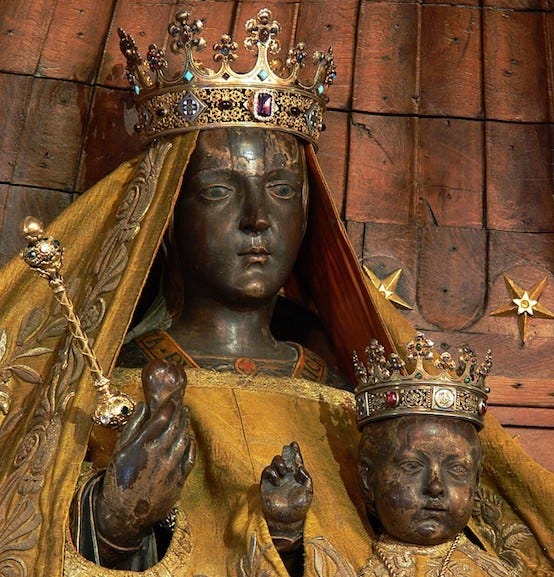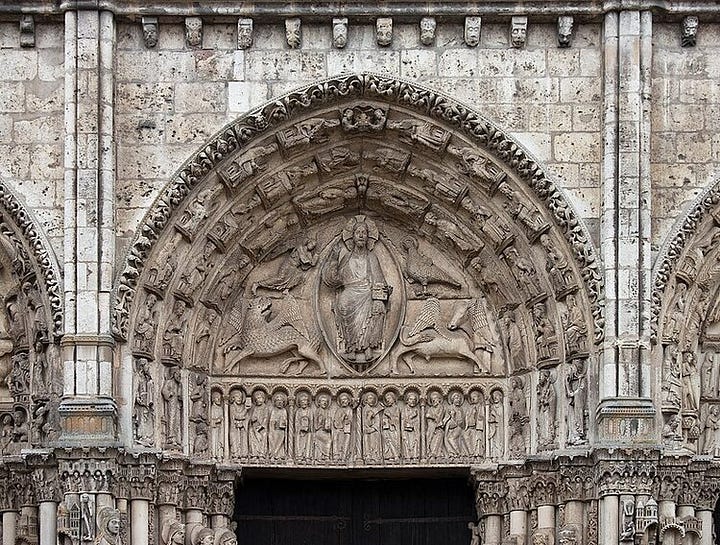Before the Renaissance, there was an earlier flourishing of Classical culture in Europe. This occurred in the Middle Ages, when nine knights undertook excavation work at the Temple Mount of Jerusalem.
The Templars
St. Bernard of Clairvaux, the most influential preacher in Christendom, spoke on their behalf at the Council of Troyes in 1129. This resulted in the Templar Order being officially chartered and endorsed by the Catholic Church. The Templars became one of Europe’s largest charitable organizations. The Pope exempted them from taxes, and allowed them to pass freely across national borders. The Templars were exempt from all political sovereignty, and were only answerable to the Papacy. The Templars received their funding from donations. They accepted letters of credit, and opened up banks in several countries. They effectively became the first multinational corporation. An abundance of gold was at their disposal.
Cult of the Virgin
St. Bernard played an indispensable role in popularizing the Catholic cult of the Virgin Mary. He wrote several theological treatises on the subject. In the Early Middle Ages, the Virgin played only a minor role in Christian theology. But as the Middle Ages progressed, the rise of emotional Christianity in the 13th century coincided with the emergence of Marian devotions. The Virgin Mary was seen as the primary intercessor between God and humanity. “No one can enter heaven unless by Mary, as through a door,” Bernard wrote. In medieval illuminated manuscripts, Bernard was often depicted receiving a stream of breast milk from Mary’s bare, supple white breast. Such a strange depiction borders on the erotic, but it definitely demonstrates the undying devotion of medieval Catholics to their Heavenly Queen. This epithet was originally used for the pagan goddess Isis. Bernard reintroduced this non-Christian deity to the West under the veil of Mary. As the mastermind behind the Templar and Cistercian orders, Bernard’s writings had a major intellectual influence on the burgeoning Gothic style across medieval Europe for the next 300 years. In his book On Building, Bernard wrote, “There must be no decoration, only proportion.” This influenced the medieval architectural ideal of sacred geometry, which is reflected in Chartres Cathedral.
Mary’s tunic
Although Chartres began construction a few decades after Bernard’s death, the site had long been a pilgrimage center dedicated to the Virgin Mary. Since 876 AD, it housed the Sancta Camisa, a tunic alleged to have been worn by the Virgin Mary. When the site burned down, it was feared that the tunic was lost. When the tunic was discovered unharmed in the ashes, this was deemed a miracle. The unlikely survival of the religious relic spurred interest by medieval Christians in this site. A building project was thus begun. Chartres became the first-ever cathedral to be dedicated to Notre Dame, which is French for “Our Lady.” Chartres remains one of the most outstanding examples of medieval Gothic architecture.
Classical revival
Chartres was much more than a dusty old church. It housed a cathedral school, which saw a resurgence in Pythagorean and Platonic philosophy. It saw the reintroduction of those Classical ideas for the first time in a thousand years. The Greek philosopher Pythagoras is commemorated by a sculpture in the right bay of the Royal Portal tympanum. The seven liberal arts composed the curriculum at the School of Chartres. The seven arts were split into two groups, the trivium and the quadrivium. The trivium consisted of logic, grammar, and rhetoric. It is the Latin basis for our English word “trivial,” because those were seen as basic, easy-to-learn skills. The quadrivium consisted of music, astronomy, number, and geometry. The liberal arts were reserved for the aristocracy. The servile arts—what might be called “trade school” today—were taught to those employed by the elites. These were the practical skills required by farmers, blacksmiths, carpenters, stone masons, and other working-class professions. Vitruvius’ Ten Books of Architecture recommended using the human body as a model for temple architecture. This Classical architectural ideal was happily co-opted by medieval Christians for their Gothic cathedrals. The cathedral’s design has many astronomical undertones. It was designed as a tangible calendar, similar to the Roman Pantheon.
Black Madonna
Before the Christian era, the grotto below Chartes was a Druidic shrine to the goddess Isis. Above the crypt today, there is a black Madonna and Child image, called Our Lady of the Pillar. Some scholars suspect the image may predate Christianity. The Druid grotto housed a sacred dolmen, which was identified with the Womb of the Earth. Both Isis and Mary were identified in their respective traditions as the Queen of Heaven. Both had sons, who symbolized the Sun. For Isis, this was Horus. For Mary, this was Jesus. The two Sun deities shared the same birthday. The story of Jesus and Mary could be considered a recapitulation of the ancient Egyptian myth of Isis and Horus. The Black Madonna appears to hint at being Isis, a goddess of African origins.
Labyrinth
Although it appears maze-like, Chartres’ labyrinth only has a single path. The eleven concentric rings match the cosmology of Ptolemy. It represents the spiritual dimension of the cosmos, and the inner journey of the soul. Some connections have been drawn with Arab alchemy, which represent eternal life.
Last Judgment
The tympanum above the central front doors of the Royal Portal depicts the Last Judgment. Jesus stands rigid and firm, surrounded the traditional symbols of the Four Evangelists: a man, eagle, lion, and bull. Those symbols come from Ezekiel’s vision in the Old Testament, as well as John of Patmos’ vision in the Book of Revelation.
Gallery




Learn More





